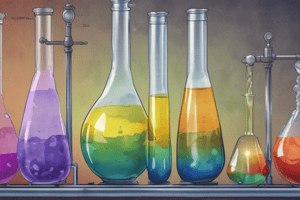Podcast
Questions and Answers
What do pH tests tell us?
What do pH tests tell us?
- They measure the amount of H+ and OH- ions in solution (correct)
- They show the color of the solution
- They determine the viscosity of the solution
- They indicate the temperature of the solution
Describe the pH scale.
Describe the pH scale.
pH 0-6 = acidic; pH 7 = neutral; pH 8-14 = basic.
What is a neutralization reaction?
What is a neutralization reaction?
Adding an acid and a base together to reach pH 7.
What are the properties of acids?
What are the properties of acids?
Provide two examples of acids you could find in your home.
Provide two examples of acids you could find in your home.
What are the properties of bases?
What are the properties of bases?
Provide two examples of bases you could find in your home.
Provide two examples of bases you could find in your home.
Classify the substance 'orange juice' (pH = 3.5).
Classify the substance 'orange juice' (pH = 3.5).
Classify the substance 'drain cleaner' (pH = 13).
Classify the substance 'drain cleaner' (pH = 13).
What can you tell your classmate about the neutralization reaction result with a pH of 9?
What can you tell your classmate about the neutralization reaction result with a pH of 9?
How is pH related to the concentration of hydrogen (H+) ions in an acidic solution?
How is pH related to the concentration of hydrogen (H+) ions in an acidic solution?
How is pH related to the concentration of hydroxide (OH-) ions in a basic solution?
How is pH related to the concentration of hydroxide (OH-) ions in a basic solution?
How is pH related to the concentration of H+ and OH- ions in a neutral solution?
How is pH related to the concentration of H+ and OH- ions in a neutral solution?
Flashcards are hidden until you start studying
Study Notes
pH and Its Significance
- pH indicates whether a solution is acidic or basic, measuring levels of H+ and OH- ions.
- Acidic solutions: pH ranges from 0 to 6; neutral: pH 7; basic: pH ranges from 8 to 14.
Neutralization Reactions
- Neutralization involves mixing an acid and a base, with the goal of achieving a pH of 7.
Properties of Acids
- Acid characteristics:
- pH 0 to 6
- Strong acids: pH 0 to 2; weak acids: pH 5 to 6
- Sour taste, corrosive to metals, conduct electricity.
- Common acids: orange juice (pH 3.5), vinegar.
Properties of Bases
- Base characteristics:
- pH 8 to 14
- Strong bases: pH 12 to 14; weak bases: pH 8 to 9
- Bitter taste, slippery texture, conduct electricity.
- Common bases: ammonia, bleach.
Classification of Substances
- Orange juice: classified as acidic.
- Drain cleaner: classified as basic.
Understanding Neutralization Outcomes
- In a reaction producing a basic pH (e.g., pH 9) despite equal volumes of acid and base, the stronger base influences the final pH more than the weaker acid.
pH and Ion Concentration in Solutions
- In acidic solutions:
- H+ concentration exceeds OH- concentration; lower pH indicates stronger acid.
- In basic solutions:
- OH- concentration exceeds H+ concentration; higher pH indicates stronger base.
- In neutral solutions:
- H+ and OH- concentrations are equal, resulting in a pH of 7.
Studying That Suits You
Use AI to generate personalized quizzes and flashcards to suit your learning preferences.




